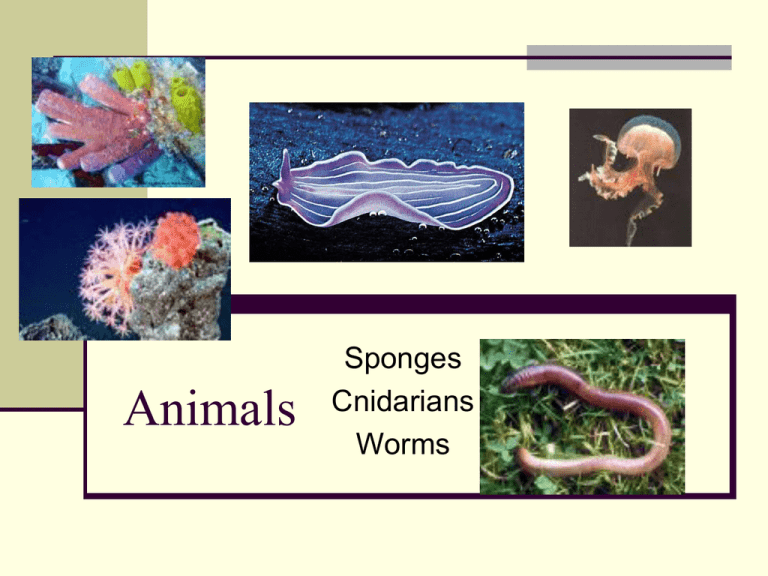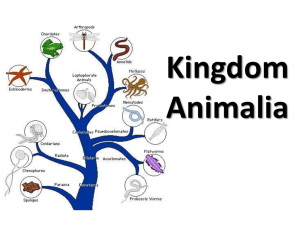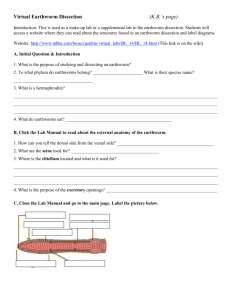Earthworms and the Environment
advertisement

Animals Sponges Cnidarians Worms What is an Animal? Characteristics Made of Cells Heterotrophs (cannot make own food) Organized Structure a. Cells – Basic Unit of Life b. Tissues – Organized Cells c. Organs – Organized Tissues d. Organ Systems -Organ Teams Animal Information Functions 1) Obtain Food 2) Obtain Oxygen 3) Movement 4) Reproduction a. Asexual (1 parent) b. Sexual (2 parents) Classification 1) Evolution – based on science information 2) 2 Levels a. Vertebrates (backbone) b. Invertebrates 3) System based on: a. Relationship to others b. Body Structure c. Development d. DNA Animal Classification - Hypothesis Vertebrates Backbones Birds Reptiles Mammals Amphibians Fish Invertebrates No Backbones 97% of Animal Population Sponges Cnidarians Echinoderms Flatworms Roundworms Worms Characteristics Invertebrates Long, narrow body No legs Bilateral symmetry (Head/Tail/organs) Nervous system Reproduction Sexual Asexual Classification Flatworms Free living - planarians Parasite – tapeworms, flukes Scavengers - planarians Roundworms Moist environments Tiny and abundant Segmented worms Linked sections closed circulatory system Earthworms and the Environment 7th Grade Earthworms – Phylum Annelida Segmented worms (earthworm and leeches) Scientific Name: Lumbricus terrestris . Earthworms – Important to Farmers Earthworms improve the soil in the following ways: They eat their way through the soil They mix the ingested material helping to improve soil Depositing soil in different places and mixing horizons. Improve drainage of heavy clay soils Introduces more air into the soil. When they die they further increase the amount of organic matter Earthworm Anatomy Earthworm - Vocabulary Muscular-Skeletal Setae - bristles on segments that help with movement Muscles – two sets, one (long/ thin) one (for width) Digestive System Nervous - Simple brain, Nerve cord Circulation - Blood , Blood vessels , Aortic arches – 5 simple hearts Respiration - No lungs , Oxygen exchange through its skin, Gives off carbon dioxide Skin must stay moist for survival Reproduction – Sexual, Hermaphroditic – Both Male and Female Parts Eggs fertilized by the sperm of another worm Batch of eggs laid at one time Excretion - Nephridin - lead to pores in skin for waste removal Symmetry - Bilateral symmetry Coloration - Brown, tan, etc. Earthworm - Vocabulary Digestive System 1) Mouth – Gathers dirt with plant/animal matter 2) Esophagus – Moves food from mouth to crop 3) Crop - Stores the food 4) Gizzard - Grinds the food 5) Intestines - Move nutrients to the body 6) Anus - Food removal Earthworm Anatomy Earthworm Anatomy – Mouth Section Earthworm – Internal Anatomy Level 2 Earthworm Anatomy Earthworm - Reproduction Hermaphroditic – Both Male and Female Parts Need two worms for fertilization Earthworm – Circulatory System 1 – Aortic arches (heart) 2 /3 – Blood Vessels Earthworm – Digestive System 1 Anus 2 Intestine 3 Cerebral ganglion 4 Prostomium 5 Mouth 6 Nerve collar 7 Segmental ganglion 8 Pharynx 9 Esophagus 10 Segmental nerve 11 Crop 12 Gizzard 13 Nerve Earthworm - Dissected




